
Masinloc, Philippines: It was about 4pm when the Chinese Coast Guard and maritime militia vessels loomed up beside Joseph Sacares’ boat.
The 53-year-old Filipino fishing captain had anchored his trawler near the entrance of Scarborough Shoal – a triangle-shaped group of rocks and reefs 220 kilometres west of the Philippine mainland – so he and his 27-member crew could rest after three days at sea.
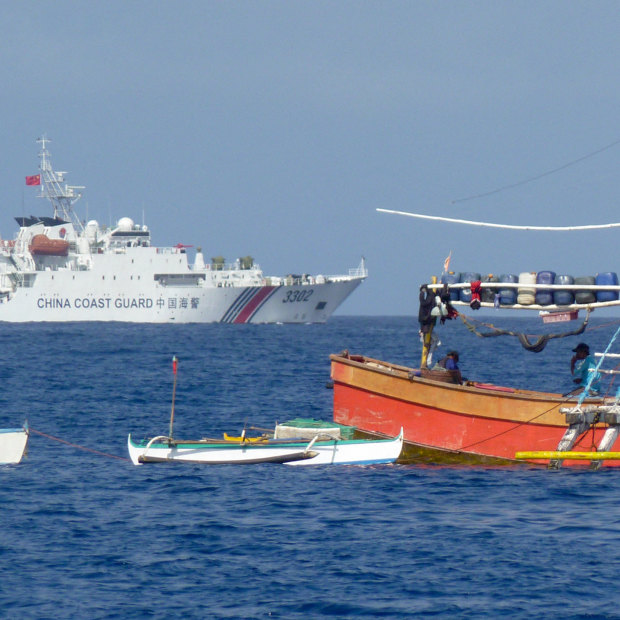
A Philippine fishing boat near Scarborough Shoal, where the Chinese Coast Guard patrols.Credit: AFP
“The Chinese Coast Guard saw us, and there was another militia vessel plus three rubber [speed] boats. The militia boat had a water gun at the back and it turned around so the water gun was facing us,” Sacares said .
“We had no option but to leave the area. The three rubber boats tailed us to make sure we did. We went back to where we came from.”
The incident, which he said occurred on May 4, was the latest episode of harassment and intimidation of Filipino fishermen by Chinese forces in the South China Sea.
It is a pattern that has been all too familiar as Beijing flexes its muscles in the resource-rich, strategically key waterway, assertively expanding its presence and militarising artificial islands with airfields and anti-aircraft capability.
Amid rising tension, the Philippine government has lodged dozens of diplomatic protests with China since President Ferdinand “Bongbong” Marcos jnr took office last year, taking umbrage at incursions into its maritime territory, near collisions with Manila’s own coast guard and the shining of a laser that temporarily blinded some of its personnel.
The situation in the West Philippine Sea, as the South-East Asian nation refers to the disputed expanse of water it faces, has now led it to discuss joint maritime patrols with Australia and resuming them with the United States.
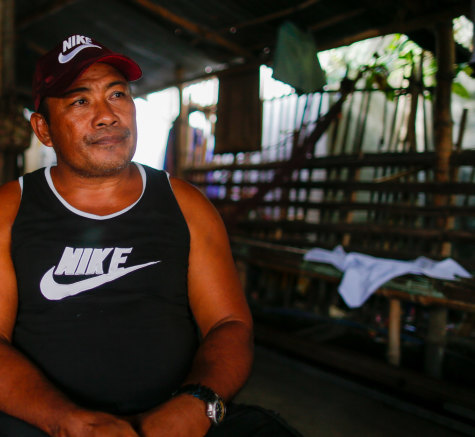
Fishing boat captain Joseph Sacares at his home in Masinloc.Credit: Jeoffrey Maitem
It is a proposal being considered by Canberra that some analysts welcome as a way of standing up to Chinese aggression. Others warn that it could pose a risk of provocation.
For the Filipino fishermen who have borne the brunt of Beijing’s behaviour, any extra help may be useful.
In Masinloc, they had for decades made a living by fishing at Scarborough Shoal, the largest atoll in the South China Sea and a 12- to 18-hour journey from the coast by boat depending on the weather.
The area, called Panatag Shoal by the Philippines, lies well within the country’s exclusive economic zone but, in 2012, China, which claims it as part of its historical territory, seized it following a two-month stand-off.
Since then, it has been off limits to Filipino trawlers as the Chinese coast guard lurks around its 46-kilometre perimeter, although smaller fishing boats have still been permitted inside.
Leonardo Cuaresma, the head of the New Masinloc Fishermen Association, said they were treated like thieves in their own fishing grounds.
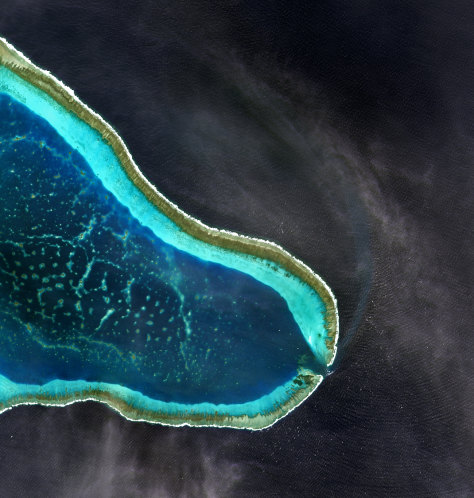
A satellite image of Scarborough Shoal, known for its rich fishing waters.Credit: Getty
“Even though the [Philippines] owns the location, it seems like we are the thieves because the ones given the priority there and being protected are the Chinese fishermen. They are being protected by their coast guard,” he said.
Cuaresma said fishermen from the town had been sprayed by water cannon and had catches of fish from their boats taken by the Chinese in exchange for expired packets of noodles.
They have also complained that Chinese fishermen have been destroying the coral reef and poaching giant clams inside the shoal.
Unable to venture to the shoal to fish or, importantly, take shelter from rough conditions, trawlers from Masinloc now operate outside it, hanging items such as car tyres from floating devices to create artificial reefs, or payao as they call it, to attract fish.
The livelihoods of their crew have been affected because many owners of larger fishing vessels had sold up, wary of their catch being decimated by a lack of access to the shoal, Cuaresma said.
“The best move right now is to retake all that the Chinese have taken from the Philippines government,” he said.
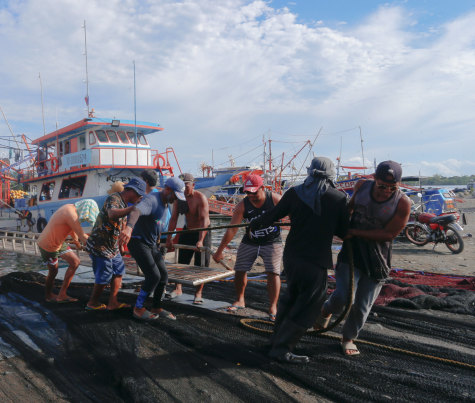
Fishermen unload a trawler in Masinloc.Credit: Jeoffrey Maitem
“If the Chinese government sees us with less allies ... then the bullying and intimidation will continue. At last if they see we have allies, they might think twice.”
‘War of radio challenges’
An international tribunal ruling at The Hague in 2016 that found in favour of the Philippines, concluded there was no legal basis for China’s “nine-dash line”, under which it claims about 90 per cent of the South China Sea.
But Beijing dismissed the decision and the maritime sovereignty of Vietnam, Malaysia, Taiwan and Brunei, as well as Indonesia, whose waters near the Natuna Islands, just beyond the South China Sea, are also regarded by China as its own.
In the contested Spratly Islands, the Philippines has for almost a quarter of a century laid physical claim to the Second Thomas Shoal, or Ayungin Shoal. A rusting Philippine Navy ship was intentionally run aground there in 1999.
The ship remains manned by a rotating crew of navy personnel but Chinese vessels have taken to obstructing the regular resupply missions from the Philippines, reacting to what Beijing sees as an intrusion of its own territory.
It was on one of these missions in February that a Philippine coast guard boat accompanying the resupply effort had a laser aimed in its direction, drawing a strong rebuke from Manila.
Last month, there was also almost a collision between Chinese and Philippine coast guard vessels near Second Thomas Shoal during a patrol with Filipino media on board.
In March, Filipino journalists on a coast guard flight over the Spratly Islands reported a Chinese order for the aircraft to “leave immediately”.
“This is the normal engagement. It has been happening so many times in the past,” Philippine Coast Guard spokesman Rear Admiral Armando Balilo said when asked about the near collision.
The Philippines faces a monumental task patrolling the sea surrounding it.
Its coast guard has 28 vessels – the first eight of which were provided by Australia between 1998 and 2007 – as well as two helicopters and three planes, but the area of coverage is enormous.
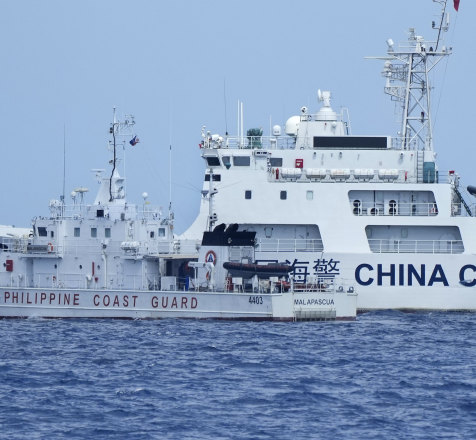
There was a near collision at Second Thomas Shoal last month when a Chinese Coast Guard ship blocked a Philippine Coast Guard vessel.Credit: AP
“Our presence means a lot to them,” Balilo said of Filipino fishermen. “Every time they see a coast guard [vessel] they will always tell us they have peace of mind.
“The challenge for us is we are an archipelago. We have porous borders and limited resources, limited vessels and limited personnel to guard the borders.
“We have 37,000 kilometres of coastline and only 26,000 coast guard personnel. Even if you include the navy and the police, we are still short of the requirement to patrol these areas.”
In the past fortnight, the Philippines has attempted to assert its position further by placing navigation buoys with its national flag in the waters of the Spratly Islands.
The move, which Balilo said reflected “the authority of the coastal state that is the Philippines”, was criticised by Vietnam, which claims sections of the Spratly chain and which has also reported several close run-ins with Chinese vessels there this month. China has since moved its own buoys near disputed reefs.
Loading
The most recent developments come as a long-discussed South China Sea code of conduct remains elusive. Indonesia, this year’s chair of the Association of South East Asian Nations (ASEAN), has vowed to try to make it a reality, resuming talks with China to establish guardrails that might avoid an escalation of hostilities.
Australia’s Minister for Foreign Affairs Penny Wong has implored South-East Asian countries not to concede any ground in the writing of such a code.
“What we have said is we would urge ASEAN not to agree [on] anything which derogates from the rights of states under international law,” she said in an interview with CNN Philippines during a visit to Manila on May 17.
“We respect ASEAN centrality and they have, as an entity, a right to discuss these issues. All we are saying as a party that has an interest, as many do in the South China Sea and in international law, is we would urge states not to agree to anything that lessened their rights.”
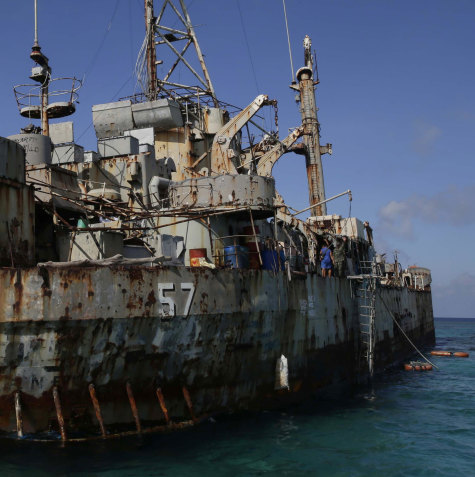
The rusting Philippine Navy ship Sierra Madre was run aground at Second Thomas Shoal in 1999 and is still manned by a crew of troops.Credit: AP
The existing environment of increased unilateral activity and megaphone diplomacy in the South China Sea, however, carries inherent dangers.
Rommel Banlaoi, a former national security adviser in the Philippine government, said the issue of radio challenges between nations with conflicting claims and the use of lasers was part of the code of conduct negotiations.
“A war of radio challenges, if not managed ... can lead to unnecessary, unintended violent encounters,” he said. “It is a matter of time.”
‘Do we retreat or do we hold the line?’
Australia has long-standing defence relations with the Philippines, notably providing training in areas such as counter-terrorism and participating in combined military drills, the latest round of which began on May 15 in Tanay, east of Manila.
As Marcos reinforces ties with the US after the wavering of his predecessor Rodrigo Duterte, granting Washington expanded access to Philippine military bases facing Taiwan and the South China Sea, links with Australia are also growing.
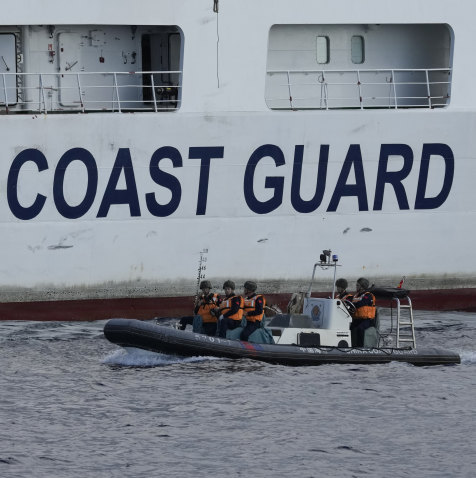
The Chinese Coast Guard and maritime militia keep watch around islands and other land features that Beijing lays claim to in the South China Sea.Credit: AP
Wong announced during her visit that Australia would provide surveillance drones and other equipment to the Philippine Coast Guard.
Deputy Prime Minister and Defence Minister Richard Marles on a trip to Manila in February flagged that Australia might enter joint maritime patrols with the Philippines.
Details of their potential scope have not yet emerged but Banlaoi, the chairman of the board of advisers at the China Studies Centre at New Era University in Quezon City, has reservations about the idea.
He said if the intention was to combat activities such as illegal fishing, maritime piracy and human and drug smuggling, it would be helpful.
“However, if the maritime patrols will be conducted in an area that is considered as disputed water that involves other parties, that will be problematic not only to the other parties but also to the region,” he said.
“For China specifically, that kind of joint patrol is not only provocative but also challenging China’s presence in the area. That is really a very risky activity for the Philippines and Australia.”
While Australian warships and aircraft, like those of the US and European powers, already carry out freedom of navigation operations in the South China Sea, they have not strayed into waters within 12 nautical miles of islands, rocks or other disputed features claimed by Beijing, wary of sparking a confrontation.
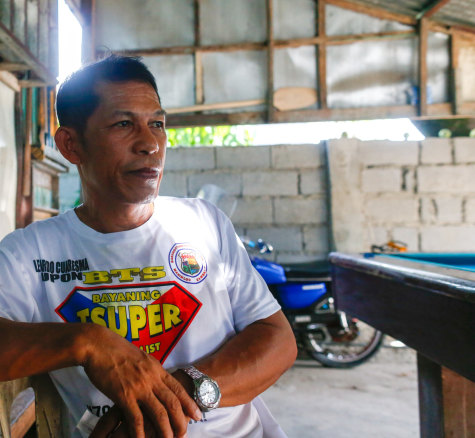
Leonardo Cuaresma, head of New Masinloc Fishermen Association, a fishing group in the Philippine province of Zambales.Credit: Jeoffrey Maitem
Hugh White, a professor of strategic studies at the Australian National University’s Strategic and Defence Studies Centre, said he would be stunned if that changed.
“If Australia, with the Philippines, were to sail through a Chinese territorial sea, that would be seen by the Chinese as a big provocation because we haven’t done it before. I’d be amazed if Australia did that,” he said.
“If we were to undertake these patrols, I think we’d stay well away from those features [China] has developed.”
In that form, he said they would fit in with the Albanese government’s desire to bolster connections in South-East Asia while treading the line between close alignment with the US and stabilising relations with China.
Loading
Marles is expected to meet Philippine Defence Secretary Carlito Galvez jnr at the Shangri-La Dialogue defence summit in Singapore this weekend. Prime Minister Anthony Albanese will be the keynote speaker on Friday.
A spokesperson for Marles did not say whether the waters around land claimed by China would be off limits to any Australian-Philippine patrols, but forecast the meeting with Galvez as a chance “to discuss ways for the two countries to work more closely together, especially our navies, in support of international law and the global rules-based order”.
“During his visit to the Philippines earlier this year, the Deputy Prime Minister spoke about Australia and the Philippines looking at options for joint military activities in the South China Sea, including the possibility of joint patrols,” the spokesperson for Marles said.
“These efforts were reaffirmed when the foreign minister visited Manila in early May.”
Jose Antonio Custodio, a fellow at the Consortium of Indo-Pacific Researchers, expects China would not be pleased with Australian-Philippine patrols but argues it can do little more than huff and puff.
“What can China do about it? Nothing, actually. If you look at what the US has been doing [with warships transiting through the] Taiwan Strait ... despite the Chinese sabre rattling, [Beijing] wasn’t able to do much. And that’s more of a core issue for them than the South China Sea,” he said.
Loading
“They can harass, they send their maritime militia to make things uncomfortable for the powers that are conducting freedom of navigation patrols. But they will not dare start a war, precisely because they’ve seen what’s happening to Ukraine in Russia. Would they want [a conflict] of their own?”
It’s a view also taken by John Blaxland, a professor of International Security and Intelligence Studies at the ANU’s Coral Bell School of Asia Pacific Affairs, who believes discussion of bilateral maritime engagement in the South China Sea raises a deeper question for Australia.
“Do we retreat or do we hold the line? Do we just cave to China’s unrecognised claims of the nine-dash line or do we insist on upholding UNCLOS [the United Nations Convention on the Law of the Sea] and the arbitral ruling of 2016?
Loading
“And do we wish to be seen by our neighbours in ASEAN as a reliable security partner with whom they should be looking to do more or are we willing to telegraph to the region that they’re on their own? By acting in collaboration with the Philippines we’re also sending a signal to Indonesia and other countries in the region that Australia is a security partner who is prepared to bolster their prospects of success.”
With Jeoffrey Maitem
Get a note directly from our foreign correspondents on what’s making headlines around the world. Sign up for the weekly What in the World newsletter here.









 Add Category
Add Category